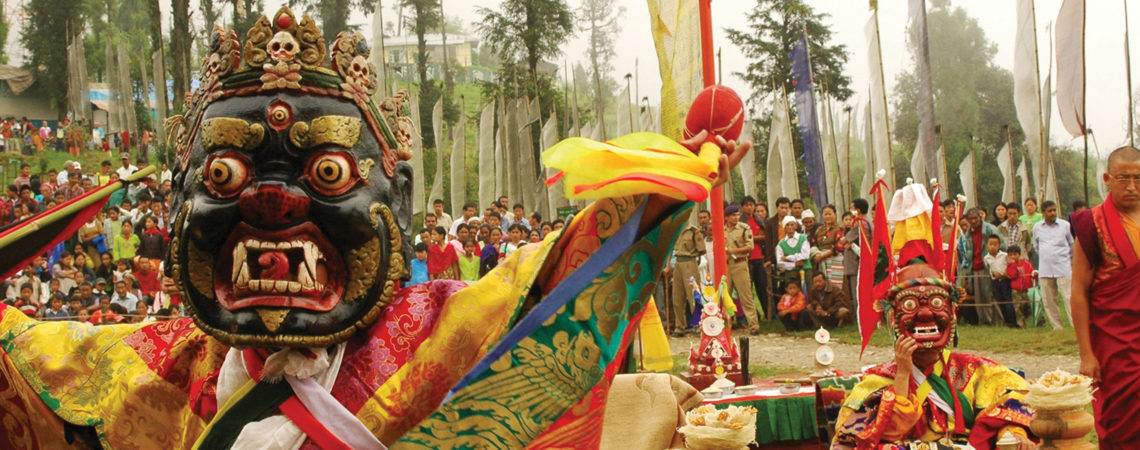Kalimpong is a hill station in the Indian state of West Bengal. It is located at an average elevation of 1,250 metres (4,101 ft). The town is the headquarters of the Kalimpong district. The Indian Army’s 27 Mountain Division is located on the outskirts of the town.
Kalimpong is known for its educational institutions, many of which were established during the British colonial period. It used to be a gateway in the trade between Tibet and India before China’s annexation of Tibet and the Sino-Indian War. Kalimpong and neighbouring Darjeeling were major centres calling for a separate Gorkhaland state in the 1980s, and more recently in 2010.
The municipality sits on a ridge overlooking the Teesta River and is a tourist destination owing to its temperate climate, magnificent Himalayan beauty and proximity to popular tourist locations in the region. Horticulture is important to Kalimpong: It has a flower market notable for its wide array of orchids; nurseries, which export Himalayan grown flower bulbs, tubers and rhizomes, contribute to the economy of Kalimpong. Home to Nepalis, non-indigenous Lepchas, other ethnic groups and non-native immigrants from other parts of India, the town is a religious centre of Buddhism. The Buddhist monastery Zang Dhok Palri Phodang holds a number of rare Tibetan Buddhist scriptures.
The Kalimpong Science Centre, established under the Darjeeling Gorkha Hill Council (DGHC) in 2008 is a recent addition to its many tourist attractions. The Science Centre, which provides for scientific awareness among the students of the town and the locals sits atop the Deolo Hill.
The precise etymology of the name Kalimpong remains unclear. There are many theories on the origin of the name. One widely accepted theory claims that the name “Kalimpong” means “Assembly (or Stockade) of the King’s Ministers” in Tibetan, derived from kalon (“King’s ministers”) and pong (“stockade”). It may be derived from the translation “ridge where we play” from Lepcha, as it was known to be the place for traditional tribal gatherings for summer sporting events. People from the hills call the area Kalempung(“the black spurs”).
According to K.P. Tamsang, author of The Untold and Unknown Reality about the Lepchas, the term Kalimpong is deduced from the name Kalenpung, which in Lepcha means “Hillock of Assemblage”; in time, the name was distorted to Kalebung, and later further contorted to Kalimpong. Another possible derivation points to Kaulim, a fibrous plant found in abundance in the region.
Until the mid-19th century, the area around Kalimpong was ruled in succession by the Sikkimese and Bhutanese kingdoms. Under Sikkimese rule, the area was known as Dalingkot. In 1706, the king of Bhutan won this territory from the Sikkimese monarch and renamed it Kalimpong. Overlooking the Teesta Valley, Kalimpong is believed to have once been the forward position of the Bhutanese in the 18th century. The area was sparsely populated by the indigenous Lepcha community and migrant Bhutia and Limbu tribes. Later in 1780, the Gurkhas of Nepal invaded and conquered Kalimpong. After the Anglo-Bhutan War in 1864, the Treaty of Sinchula (1865) was signed, in which Bhutanese held territory east of the Teesta River was ceded to the British East India Company. At that time, Kalimpong was a hamlet, with only two or three families known to reside there. The first recorded mention of the town was a fleeting reference made that year by Ashley Eden, a government official with the Bengal Civil Service. Kalimpong was added to district of Darjeeling in 1866. In 1866–1867 an Anglo-Bhutanese commission demarcated the common boundaries between the two, thereby giving shape to the Kalimpong subdivision and the Darjeeling district.
After the war, the region became a subdivision of the Western Duars district, and the following year it was merged with the district of Darjeeling. The temperate climate prompted the British to develop the town as an alternative hill station to Darjeeling, to escape the scorching summer heat in the plains. Kalimpong’s proximity to the Nathu La and Jelep La passes (La means “pass”), offshoots of the ancient Silk Road, was an added advantage. It soon became an important trading outpost in the trade of furs, wools and food grains between India and Tibet. The increase in commerce attracted large numbers of Nepali’s from the neighbouring Nepal and the lower regions of Sikkim, the areas where, Nepali’s were residing since the Gorkha invasion of Sikkim in 1790. The movement of people into the area, transformed Kalimpong from a small hamlet with a few houses, to a thriving town with increased economic prosperity. Britain assigned a plot within Kalimpong to the influential Bhutanese Dorji family, through which trade and relations with Bhutan flowed. This later became Bhutan House, a Bhutanese administrative and cultural centre.
The arrival of Scottish missionaries saw the construction of schools and welfare centers for the British. Rev. W. Macfarlane in the early 1870s established the first schools in the area. The Scottish University Mission Institution was opened in 1886, followed by the Kalimpong Girls High School. In 1900, Reverend J.A. Graham founded the Dr. Graham’s Homes for destitute Anglo-Indian students. By 1907, most schools in Kalimpong started offering education to Indian students. By 1911, the population comprised many ethnic groups, including Nepalis, Lepchas, Tibetans, the Anglo-Indian community and the Marwari communities. Hence by 1911, the population had swollen to 7,880.
Following Indian independence in 1947, Kalimpong became part of the state of West Bengal, after Bengal was partitioned between India and East Pakistan. With China’s annexation of Tibet in 1959, many Buddhist monks fled Tibet and established monasteries in Kalimpong. These monks brought many rare Buddhist scriptures with them. In 1962, the permanent closure of the Jelep Pass after the Sino-Indian War disrupted trade between Tibet and India, and led to a slowdown in Kalimpong’s economy. In 1976, the visiting Dalai Lama consecrated the Zang Dhok Palri Phodang monastery, which houses many of the scriptures.
Communication :-
Kalimpong is located off the National Highway 31A (NH31A), which links Sevok to Gangtok. The NH31A is an offshoot of the NH 31, which connects Sevok to Siliguri. These two National Highways together, via Sevok, links Kalimpong to the plains. Regular bus services and hired vehicles connect Kalimpong with Siliguri and the neighboring towns of Kurseong, Darjeeling and Gangtok. Four wheel drives are popular means of transport, as they can easily navigate the steep slopes in the region. However, road communication often get disrupted in the monsoons due to landslides. In the town, people usually travel by foot. Residents also use bicycle, two-wheeler and hired taxis for short distances.
The nearest airport is in Bagdogra near Siliguri, about 80 kilometres (50 mi) from Kalimpong. Air India, Jet Airways and Druk Air (Bhutan) are the four major carriers that connect the airport to Delhi, Calcutta, Paro (Bhutan), Guwahati and Bangkok (Thailand). The closest major railway station is New Jalpaiguri, on the outskirts of Siliguri, which is connected with almost all major cities of the country.



